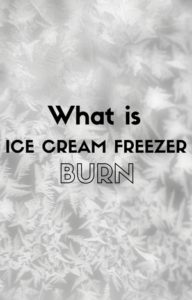What Is Ice Cream Freezer Burn?
 If you’ve been exploring the idea of purchasing an ice cream maker, you may have come across comments about the difficulty of maintaining the quality of homemade ice cream. Freezer burn is the most likely cause of this diminished quality.
If you’ve been exploring the idea of purchasing an ice cream maker, you may have come across comments about the difficulty of maintaining the quality of homemade ice cream. Freezer burn is the most likely cause of this diminished quality.
Freezer burn attacks commercially prepared ice cream too, but the homemade variety is more vulnerable for a couple of reasons.
What is freezer burn and what causes it?
Items in your freezer lose moisture even while they are frozen. Notice how ice cubes get smaller over time if they are left in their trays or bins for several weeks. Evaporation is taking place. As this happens, some of the moisture refreezes into large crystals on the surface of the food. That is freezer burn.
Also, the more your ice cream is subjected to thawing and refreezing, the more opportunity there is for ice crystal formation. Below you will find some suggestions for avoiding this problem.
Is freezer-burned ice cream safe to eat?
While it does have an unpleasant taste, and doesn’t have the smooth creaminess of the best ice cream, it is not harmful to eat. Food safety issues generally involve bacteria growth. If you’ve kept your ice cream frozen, bacteria growth won’t be a problem. The issue with freezer burn is diminished quality.
How to prevent ice cream freezer burn.
Three points to keep in mind when you are trying to prevent ice cream freezer burn:
1. proper storage
Ice cream keeps best when it is stored below 0 degrees F, so set your freezer temperature as low as possible. Place your ice cream in the lower part of the freezer and in the back portion. Even better: bury it under a lot of other items. Your goal is to keep warm air from reaching it every time you open the freezer door. Definitely do not store it in the freezer door!
2. avoid thawing and refreezing
Repeated thawing and refreezing is deadly to the quality of your ice cream. Each time this happens, more large ice crystals are formed. Try storing your ice cream in small, air-tight containers.
This allows you to bring out only the amount you intend to serve and keep the rest well frozen.
3. don’t let air get to it.
One reason homemade ice cream may be more vulnerable to freezer burn is that the container used for storing it may not be airtight. Also, the freshly made ice cream may not fill the container to the rim. In that case, the product is being exposed to air and the evaporation process can begin right away. If your container isn’t filled to the brim, place a layer of plastic wrap, waxed paper, or parchment directly on the top of your ice cream. Then place the air-tight lid on the container. This will go a long way toward minimizing contact with the air. As stated above, evaporation leads to formation of ice crystals. So when you prevent air contact you lessen the chance of freezer burn.
Reviving freezer-burned ice cream
I have not personally tried this, but I have read more than one report of people successfully reviving freezer-burned ice cream by melting and refreezing it in an ice cream maker. Certainly beats throwing it out or eating low-quality ice cream!


